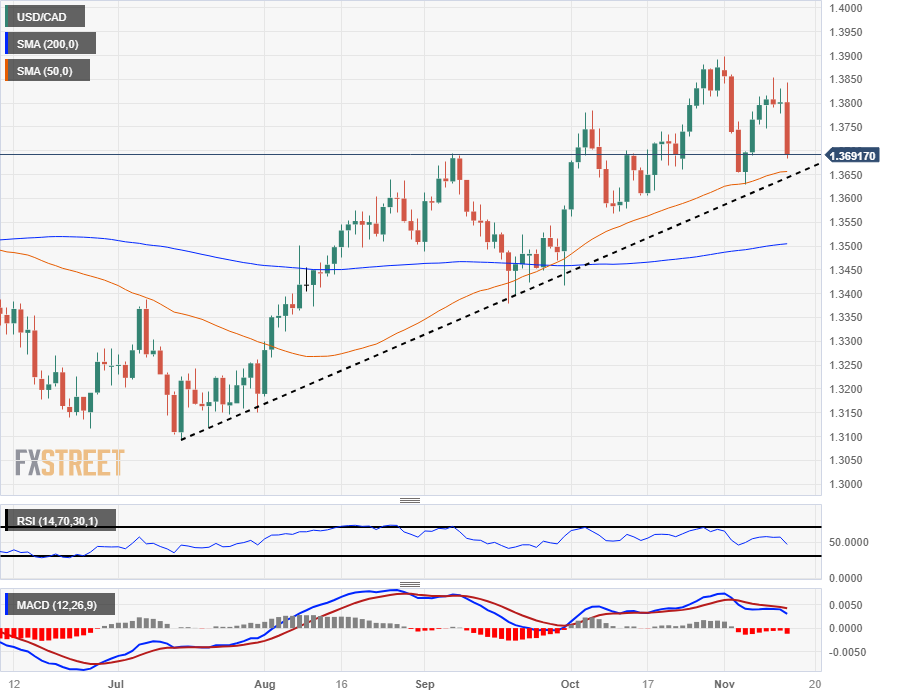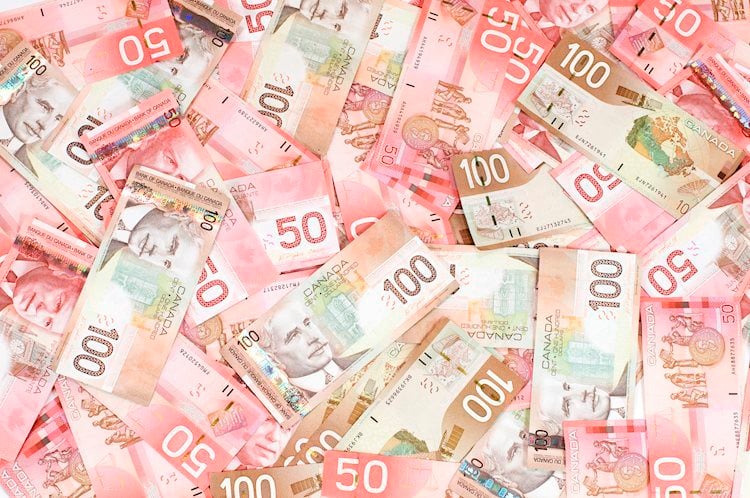- The Canadian Dollar is getting a leg up as markets turn down the Greenback.
- Canada sees little of note on the data docket this week.
- Loonie traders aren’t out of the US data woods yet, US PPI and Retail Sales come tomorrow.
The Canadian Dollar (CAD) is catching a bid thanks to a forecast miss on US Consumer Price Index (CPI) inflation figures. The data miss is sending broader markets into risk-on mode as market sentiment improves.
US CPI for October came in lower than markets had initially forecast, and the easing inflation datapoint is giving markets reason to hope that the Federal Reserve’s (Fed) “higher for longer” narrative on interest rates may not prove to be as long as previously thought.
Daily Digest Market Movers: Canadian Dollar finds a CPI-fueled rebound
- The CAD is climbing into a five-day high and its highest bids in a week thanks to the US CPI miss.
- October’s headline month-on-month US CPI came in at a flat 0.0% against the forecast 0.1%, 0.4% previous.
- Annualized CPI printed at 3.2%, down from the previous 3.7% and missing the forecast of 3.3%.
- CPI expectations are one forecast markets are eager to have missed as risk appetite surges.
- Inflation cooling faster than expected is helping investors climb back into riskier assets, including the Loonie.
- This week still sees hefty US data on the calendar, with Producer Price Index (PPI) and Retail Sales for October arriving on Wednesday
Technical Analysis: Canadian Dollar cracks 1.37 against US Dollar as markets flip risk-on
The Canadian Dollar (CAD) is heading below the 1.3700 handle against the US Dollar (USD), taking the USD/CAD pair down from the 1.3850 level for Friday.
Shorts on the USD/CAD will be looking to drag the pair back down towards the 50-day Simple Moving Average (SMA) near 1.3650. Longer-term support is coming from the 200-day SMA currently pushing into the high side of 1.3500.
Tuesday’s downturn on the USD/CAD chart is helping to solidify a potential lower high chart pattern, with a technical resistance zone building in from 1.3750 to 1.3800. Meanwhile, USD bulls will be hoping for a bounce from the rising trendline drawn from July’s swing low into 1.3100.
USD/CAD Daily Chart

Canadian Dollar price today
The table below shows the percentage change of Canadian Dollar (CAD) against listed major currencies today. Canadian Dollar was the strongest against the US Dollar.
| USD | EUR | GBP | CAD | AUD | JPY | NZD | CHF | |
| USD | -1.71% | -1.80% | -0.83% | -2.03% | -0.92% | -2.18% | -1.46% | |
| EUR | 1.68% | -0.09% | 0.87% | -0.31% | 0.78% | -0.46% | 0.25% | |
| GBP | 1.77% | 0.08% | 0.95% | -0.22% | 0.87% | -0.38% | 0.35% | |
| CAD | 0.81% | -0.88% | -0.97% | -1.19% | -0.11% | -1.35% | -0.61% | |
| AUD | 1.99% | 0.30% | 0.21% | 1.17% | 1.08% | -0.16% | 0.57% | |
| JPY | 0.91% | -0.79% | -0.87% | 0.09% | -1.14% | -1.23% | -0.53% | |
| NZD | 2.13% | 0.45% | 0.37% | 1.33% | 0.15% | 1.23% | 0.71% | |
| CHF | 1.45% | -0.24% | -0.33% | 0.63% | -0.54% | 0.55% | -0.70% |
The heat map shows percentage changes of major currencies against each other. The base currency is picked from the left column, while the quote currency is picked from the top row. For example, if you pick the Euro from the left column and move along the horizontal line to the Japanese Yen, the percentage change displayed in the box will represent EUR (base)/JPY (quote).
Inflation FAQs
Inflation measures the rise in the price of a representative basket of goods and services. Headline inflation is usually expressed as a percentage change on a month-on-month (MoM) and year-on-year (YoY) basis. Core inflation excludes more volatile elements such as food and fuel which can fluctuate because of geopolitical and seasonal factors. Core inflation is the figure economists focus on and is the level targeted by central banks, which are mandated to keep inflation at a manageable level, usually around 2%.
The Consumer Price Index (CPI) measures the change in prices of a basket of goods and services over a period of time. It is usually expressed as a percentage change on a month-on-month (MoM) and year-on-year (YoY) basis. Core CPI is the figure targeted by central banks as it excludes volatile food and fuel inputs. When Core CPI rises above 2% it usually results in higher interest rates and vice versa when it falls below 2%. Since higher interest rates are positive for a currency, higher inflation usually results in a stronger currency. The opposite is true when inflation falls.
Although it may seem counter-intuitive, high inflation in a country pushes up the value of its currency and vice versa for lower inflation. This is because the central bank will normally raise interest rates to combat the higher inflation, which attract more global capital inflows from investors looking for a lucrative place to park their money.
Formerly, Gold was the asset investors turned to in times of high inflation because it preserved its value, and whilst investors will often still buy Gold for its safe-haven properties in times of extreme market turmoil, this is not the case most of the time. This is because when inflation is high, central banks will put up interest rates to combat it.
Higher interest rates are negative for Gold because they increase the opportunity-cost of holding Gold vis-a-vis an interest-bearing asset or placing the money in a cash deposit account. On the flipside, lower inflation tends to be positive for Gold as it brings interest rates down, making the bright metal a more viable investment alternative.
